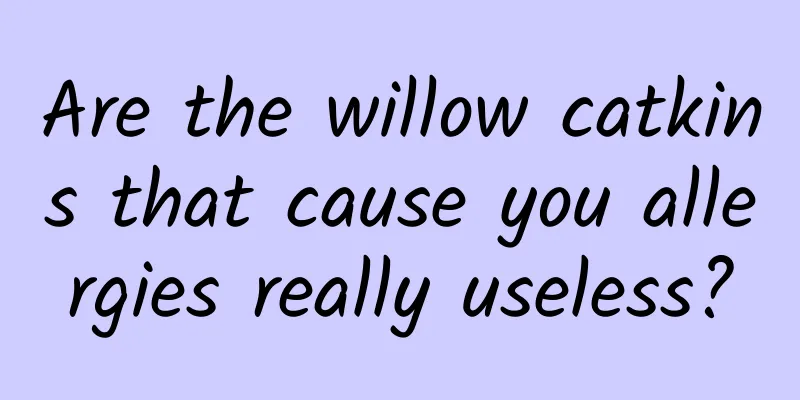Are the willow catkins that cause you allergies really useless?

|
There is static electricity in winter and heat in summer, there are flying catkins in spring and pants in autumn. ——Life is really a gorgeous robe, which makes us itchy all year round. In April, many cities have high-energy warnings ahead, because the annual overwhelming screen-dominating bullet comments are here again! There are 2 million such trees in Beijing; each tree produces 280,000 to 14.85 million white fluffs each year, weighing about 1 kilogram; the total is 2,000 tons. An elephant weighs 5 tons, so in April, the capital was bombarded by 400 albino elephants. To put it mildly, a cumulus cloud weighs 500 tons, so we were just fuming in 4 clouds. (Walking down the street in spring, I often feel like I’m still sitting in front of a computer) The most famous poem about catkins throughout history says: "Catkins are the essence of willows" - when the spring breeze blows on your face, isn't this large-scale, open, cross-species sexual harassment? In fact, this phrase is scientifically wrong. Let’s organize a quick introduction to “white catkins” and then explore a question: Even if they cannot be used to weave cloth, are catkins really useless except for lighting a fire to make people with obsessive-compulsive disorder feel good (very dangerous, don’t try)? Willow Tree Physiological Hygiene, Newlywed Life, Family Planning Quick Answers Manual one, Q: Are the white fluff sperm, eggs, or seeds of the willow? Answer: Strictly speaking, neither. Spring is here, and everything is mating. The stamens are sincerely offering pollen to the pistils. Some plants are monoecious and do their own things; some plants are dioecious and need wind, water, insects, and birds to help them, and most willows are like this. (Left: Female willow flower; Right: Female poplar flower) After getting the pollen from the male willow, the female willow will produce fruit. The fruit contains white fluff, which contains seeds. When the fruit matures and cracks, the white fluff carries the seeds with it and is blown away by the wind, sowing widely and yielding little, sometimes completely annihilating the whole plant. (Left: Microscopic view, the fruit of a female poplar tree is splitting; Right: Macroscopic view, the white fluff is ready to take off) Therefore, the pollen of male willow is the "essence" (strictly speaking, pollen is not equal to plant sperm), and the small black particles in the white fluff of female willow are the seeds. (Seeds in white fluff) Fortunately for the motherland, the catkins are not Liu Jingyuan. The poorest ones are the island people, one quarter of the Japanese suffer from hay fever, which is caused by the cedar and cypress trees that make up one third of their natural forests, which are becoming unruly. (Japanese cedar trees spray pollen in a cloud of ashes) So, when the spring breeze blows for ten miles, don’t make the mistake of castrating the willows. When white catkins spray the city, it is not the male willows’ fault, but the female willows drying their babies. … Showing off your baby?! two, Question: How to curb the crazy behavior of showing off children? Answer: Family planning. (Isn’t it cruel? Does it make you feel better?) 1. Contraception: Apply "Inflorescence Thinning Agent" externally to the mother willow to prevent it from bearing fruit, and take "Flower Inhibitor No. 1" internally to prevent it from growing flowers. (After drilling, injection and sealing, "Flower Inhibitor No. 1" rises from the trunk to the crown due to transpiration) 2. Transformation: For the female willows, they are "grafted" by cutting off the upper half and grafting male willows on them to let them grow into them. (To ensure the survival after grafting, continue to spray water for dozens of days) 3. Favoring sons over daughters : Plant more male willows and fewer female willows, and carry out activities that are in the late stage of male chauvinism, such as the "One Million Male Willows Entering Beijing" in 1994. 4. Throw cold water : a way of fighting violence with violence to deal with naughty children. (Bombing the bear baby) three, Question: Why can’t it be curbed? Answer: Expensive. There are 2 million mother willow trees in Beijing. Calculate the cost: 1. Contraceptive pills only work for one year, so you have to take them every year. "Flower Inhibitor No. 1" costs 10 to 15 yuan per plant. 2. High-end grafting is only suitable for short trees. It is time-consuming and labor-intensive, and it costs 100 yuan to replace one tree. 3. You can't pull out the roots, there aren't that many Lu Zhishen. Also, it's impossible to tell the gender of a willow tree when it's a young seedling. In fact, there are still a lot less white fluff than in previous years. There has to be a process, right? Four, Question: Why did you have to plant so much in the first place? Answer: Cheap. Oh no, it’s cheap. They grow fast, live longer, stay green longer, provide a lot of shade, are not afraid of drought or insects, and are not worth much... There are two common species of willows in North China, one is called "white-haired poplar" and the other is called "dried willow". Just by hearing these bitter names, you can tell how happy they are. In addition, when they moved to Beijing in large numbers from Yi County, Hebei Province in the 1970s, Yang Liu and his friends were still young. Now that they are old, they have more "problems". Yang Liuxu Re-employment Guidelines Although humans dislike poplar and willow catkins, in addition to writing poems about them, they also want to find some proper way out for them. 1. Entering the catering industry? You must have eaten fake catkins A random search will reveal a wide variety of willow catkin recipes: "Cold willow catkins", "willow catkin crispy rolls", "willow catkin fried meatballs", "red oil and silver thread willow catkins", "willow catkin tea", "willow catkin buns"... Is it really ugly? Just look at the picture: (“Cold willow catkins” is actually young willow flowers) After people break off branches and strips to destroy urban greening, what they bring home to cook is actually the catkins of the willow tree, not the catkins. The catkins are also removed in the first step of washing and blanching. In the above recipes, it is better to call them "willow spikes". 2. Entering the textile industry: Poplar fluff vs. long cotton, wool, down, silk, polyester At first glance, the prospects seem bleak. Common sense would say: poplar fluff is too short to be woven into cloth; it is too loose to be used as filling material even if it is flattened or rolled into a ball; and it is even worse at keeping warm - haven't you heard the childhood story of the cruel stepmother making winter clothes: the stepdaughter, who was freezing to death, discovered that her own son's coat was stuffed with cotton, while her own coat was stuffed with willow fluff. Unfortunately, common sense is not entirely scientific. After working day and night to examine it with an optical microscope, burn it with an alcohol lamp, wash it with a washing machine, dry it with a dryer, soak it with chemical reagents, and test it with a dummy wearing a vest... the textile scientists who had tortured the poplar fluff evaluated the physical and chemical characteristics of its fibers: (Poplar fluff fibers under an electron microscope. Image source: Chen, H. & Cluver, B. 2010 “Assessment of Poplar Seed Hair Fibers as a Potential Bulk Textile Thermal Insulation Material” Short. Length ranking: poplar < long cotton < wool < silk. Diameter ranking: poplar fluff ≈ silk < long cotton < wool. The hollowness is extremely large, about 80% to 90%. The ranking of the size of the middle cavity is: poplar < ramie < long cotton. Excellent water repellency. High fill power, and very fast recovery. Fill power ranking: poplar fluff > down > wool. Good thermal insulation. Thermal resistance ranking: poplar fluff ≈ polyester ≈ wool < down. What do these characteristics determine? Poplar fluff fibers are too short, so as common sense suggests, they cannot be spun in their entirety, nor can they be woven into cloth. However, they are very thin and hollow, so they have a low specific gravity and are light. They are fluffy, warm, and washable, so they can be used as fillings for pillows and mattresses. They are also water-repellent and non-hygroscopic, making them suitable for humid environments, so they can be used to make sleeping bags and tents for outdoor use. In addition, they are biodegradable, so they are environmentally friendly. Down is warm but too heavy, wool is warm but absorbent, and polyester is light but not environmentally friendly. All these factors combined have allowed poplar fluff to carve out a niche. In 2006, it was named the "Fiber of the Year" in Germany. Of course, relevant research is still in its early stages. The difficulty lies mainly in collection, impurity removal and shaping, not in the scale of planting: although the output of poplar fluff is not as good as cotton, it is said to be better than cashmere and mohair. Many European companies are eyeing the vast poplar forests in Oregon, USA. 3. Entering the oil industry: Poplar fluff absorbs oil Poplar fluff fibers hate water but are oil-loving, and they have a large hollow structure, so they absorb oil very quickly. If they are made into oil-absorbing felt and oil-absorbing rope materials, and used in places where oil and water are mixed, such as on the sea surface polluted by oil, is it okay? In 2015, the Canadian Poplar and Willow Council received a letter from a Slovenian company: "Sorry to contact you directly. We need a large amount of poplar fluff and are looking for long-term strategic partnerships in major poplar growing areas around the world." The head of this company did a study: with a compression density of 0.005 grams per cubic centimeter, 1 gram of poplar fluff can absorb about 200 grams of heavy oil, which exceeds all natural oil-absorbing materials. Without further ado, let's take a look at the pictures: (The oil on the water surface was instantly absorbed by the poplar fluff. The picture is taken from the video posted by POSSA Online on youtube) Why not contact the gardening bureaus across the country? 4. Entering the electronics industry: Willow catkins, poplar catkins, sycamore catkins based supercapacitors Supercapacitors are energy storage devices that are between traditional capacitors and batteries, with high power density, fast charging and discharging, and long life... Let's put it in a more intuitive way: an electric bus uses 3.4 tons of lithium batteries and has a range of 120 kilometers, which takes about 5 hours to charge; while the same bus uses 0.9 tons of supercapacitors and has a range of 20 kilometers, which only takes about 7 minutes to charge. The shuttle bus for the Shanghai World Expo only takes tens of seconds to charge, and it uses supercapacitors. (Supercapacitor vehicles used in Shanghai public transportation system) five, Can Feixu, who is only concerned about showing off her baby, really enter this kind of industry? able. The core of supercapacitors lies in electrodes. Many carbon materials that can be used as electrodes are biomass: from leaves, petals, straw, to fish bones, melon seed skins, sugarcane bagasse, everything is used. Although flying catkins are short, they are better than sugarcane bagasse, right? Willow catkins, poplar catkins, and sycamore catkins are activated to make carbon microtubes, which have a very large specific surface area and excellent capacitance performance. (White is poplar fluff, light yellow is sycamore fluff, and black is activated powdered carbon material) "Good winds frequently lend me strength, sending me to the blue sky" - one can imagine Xue Baochai wearing leather pants, combing her hair into a crew cut, being invited to the listing dinner of pillow, linoleum, and supercapacitor companies, singing her lyrics of "Fly Higher" with the sentiment... six, So what can we do now? Let’s put on masks first. . . . . . . . . . . Produced by: Science Popularization China Produced by: Yinhe Road No. 16 Team Producer: Computer Network Information Center, Chinese Academy of Sciences |
Recommend
What kind of brand marketing promotion plan attracts everyone?
Brand marketing is an advanced marketing method. ...
Is it expensive to customize the Yichun meat and poultry mini program? Yichun meat and poultry mini program customization cost and process
What is the price for customizing Yichun meat and...
On the road of parenting, these 4 minefields must be avoided
Now, some parents have fallen into a big minefiel...
Hejun's Strategic Thinking Course (Issue 24)
Hejun's Strategic Thinking Course (24th Issue...
Sony ridicules PSVR: How to resolve the contradictions in the early stages of virtual reality development?
If Samsung had told everyone in advance that the ...
Apple releases iOS 11.4 beta 2 with more than just ClassKit
Recently, Apple released iOS 11.4 beta 2. Two wee...
What to do if your Apple device has problems? This official app gives you one-stop support
As early as January last year, Apple launched its...
Tips for making creative advertising promotions near WeChat, use them well to triple your sales! Case Analysis
"The Big Dipper points to the southeast, and...
What are the functions of the Guangzhou Early Childhood Education Mini Program? How much does the early childhood education center mini program cost per year?
"I hope my son will become a dragon and my da...
What should we do if the ocean also loses hair? Its "hair transplanter" turns out to be seaweed
Produced by: Science Popularization China Author:...
See how 8 industry-leading brands interpret the effectiveness of information flow advertising
In recent years, information flow ads have become...
An analysis of the operation of a maternal and infant APP product activity
This month we planned a WeChat fan-raising activi...
Why do we have to rack our brains to predict protein structure?
Did you know that there are hundreds of thousands...
My eyes are on fire while working from home. How can I cure dry eyes?
Working at a desk for a long time at home, someti...
Tesla's FSD revenue will exceed car sales, but the media believes that users are just "recharging for testing"
Recently, Tesla updated the Beta 9 version of the...









